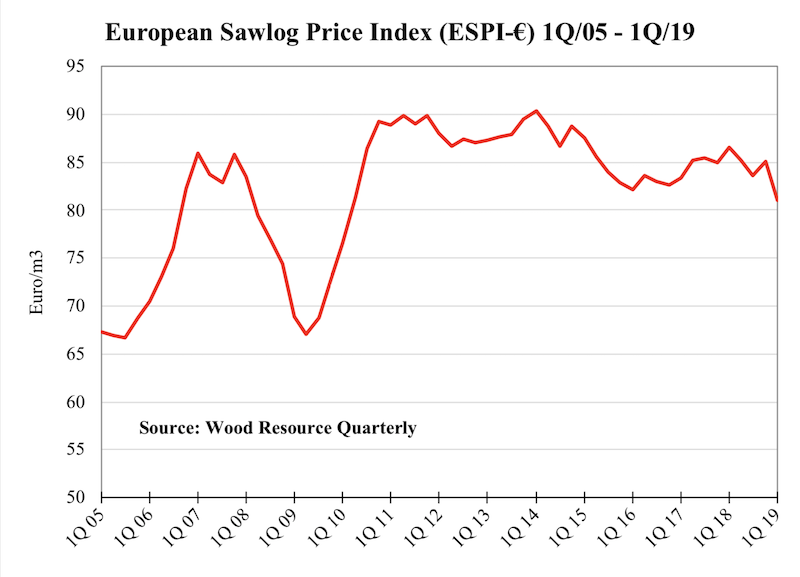The global flow of softwood logs from countries with a surplus of wood raw- material to regions with tight, or costly log supply, and higher consumption of forest products continued to expand for the third consecutive year in 2018.
Sawlog prices fell throughout the world in the 1Q/19 due to either plentiful supply or reduced demand for lumber, depending on region. The Global Sawlog Price Index (GSPI) fell 1.8% to the lowest level noted since the 2Q/17.

Note. The ESPI Price Index is composed of average sawlog prices in nine of the largest log-consuming countries in Europe. The Index tracks prices from the 1Q/95 to the current quarter and is published in the WRQ.
Global Pulpwood Prices
The Softwood Fiber Price Index (SFPI) inched up 0.5% in the 1Q/19. This was the third consecutive quarterly increase and the highest this index has seen since late 2014. Of the regions covered by the index, Russia, New Zealand and the US South contributed the most to this rise.
Most regions worldwide saw hardwood fiber prices move higher in the 1Q/19 because of a tighter supply of pulplogs. The Hardwood Fiber Price Index (HFPI) was up 2.5% from the 4Q/18 to the 1Q/19.
Global Pulp Markets
Shipments of pulp during the first three months of 2019 were down 4.1% from the same period in 2018. Uncharacteristically, Latin America was the region that reduced shipments the most.
In 2018 and early 2019, Northern Bleach Softwood Kraft Pulp (NBSK) prices fell more dramatically than those for Bleach Hardwood Kraft Pulp (BHK), shrinking the discrepancy bringing the two benchmark grades. These two indices are now the closest in price they have been in 12 months.
Global Lumber Markets
In 2018, global trade of softwood lumber reached the second highest level ever recorded.
The free fall of lumber prices in the US came to a halt in early 2019, and prices might have hit a low for this cycle in January.
Softwood lumber exports from Canada were down 6% year-over year in 2018, with the biggest decline being in shipments to China.
For the first time in five years, Swedish exports of softwood lumber fell year-over- year in 2018. The biggest declines were in exports to Asia and the MENA region, while shipments to the European market remained practically unchanged.
Despite much uncertainty in the near future for the Chinese economy, lumber imports rose unexpectedly in the 1Q/19 by as much as 14%.
Russia increased exports of softwood lumber by 7% from 2017 to 2018. This was the sixth consecutive year that exports have increased from the previous year.
Global Biomass Markets
Pellet exports from North America surged in the 4Q/18 to reach an all-time-high of almost 2.6 million tons - a continuation of an upward trend that began early 2017.
The United Kingdom continues to be the largest importer of wood pellets in the world. In 2018, the country was the destination for 36% of globally traded pellets.











